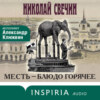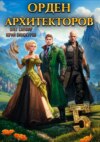Читать книгу: «Heimskringla, or the Chronicle of the Kings of Norway», страница 17
90. HALFRED VANDREDASKALD BAPTIZED.
As King Olaf one day was walking in the street some men met him, and he who went the foremost saluted the king. The king asked the man his name, and he called himself Halfred.
"Art thou the skald?" said the king.
"I can compose poetry," replied he.
"Wilt thou then adopt Christianity, and come into my service?" asked the king.
"If I am baptized," replies he, "it must be on one condition,—that thou thyself art my godfather; for no other will I have."
The king replies, "That I will do." And Halfred was baptized, the king holding him during the baptism.
Afterwards the king said, "Wilt thou enter into my service?"
Halfred replied, "I was formerly in Earl Hakon's court; but now I will neither enter into thine nor into any other service, unless thou promise me it shall never be my lot to be driven away from thee."
"It has been reported to me," said the king, "that thou are neither so prudent nor so obedient as to fulfil my commands."
"In that case," replied Halfred, "put me to death."
"Thou art a skald who composes difficulties," says the king; "but into my service, Halfred, thou shalt be received."
Halfred says, "if I am to be named the composer of difficulties, what cost thou give me, king, on my name-day?"
The king gave him a sword without a scabbard, and said, "Now compose me a song upon this sword, and let the word sword be in every line of the strophe." Halfred sang thus:
Then the king gave him the scabbard, observing that the word sword was wanting in one line of his strophe. "But there instead are three swords in one of the lines," says Halfred. "That is true," replies the king.—Out of Halfred's lays we have taken the most of the true and faithful accounts that are here related about Olaf Trygvason.
91. THANGBRAND RETURNS FROM ICELAND.
The same harvest (A.D. 999) Thangbrand the priest came back from Iceland to King Olaf, and told the ill success of his journey; namely, that the Icelanders had made lampoons about him; and that some even sought to kill him, and there was little hope of that country ever being made Christian. King Olaf was so enraged at this, that he ordered all the Icelanders to be assembled by sound of horn, and was going to kill all who were in the town, but Kjartan, Gissur, and Hjalte, with the other Icelanders who had become Christians, went to him, and said, "King, thou must not fail from thy word—that however much any man may irritate thee, thou wilt forgive him if he turn from heathenism and become Christian. All the Icelanders here are willing to be baptized; and through them we may find means to bring Christianity into Iceland: for there are many amongst them, sons of considerable people in Iceland, whose friends can advance the cause; but the priest Thangbrand proceeded there as he did here in the court, with violence and manslaughter, and such conduct the people there would not submit to." The king harkened to those remonstrances; and all the Iceland men who were there were baptized.
92. OF KING OLAF'S FEATS.
King Olaf was more expert in all exercises than any man in Norway whose memory is preserved to us in sagas; and he was stronger and more agile than most men, and many stories are written down about it. One is that he ascended the Smalsarhorn, and fixed his shield upon the very peak. Another is, that one of his followers had climbed up the peak after him, until he came to where he could neither get up nor down; but the king came to his help, climbed up to him, took him under his arm, and bore him to the flat ground. King Olaf could run across the oars outside of the vessel while his men were rowing the Serpent. He could play with three daggers, so that one was always in the air, and he took the one falling by the handle. He could walk all round upon the ship's rails, could strike and cut equally well with both hands, and could cast two spears at once. King Olaf was a very merry frolicsome man; gay and social; was very violent in all respects; was very generous; was very finical in his dress, but in battle he exceeded all in bravery. He was distinguished for cruelty when he was enraged, and tortured many of his enemies. Some he burnt in fire; some he had torn in pieces by mad dogs; some he had mutilated, or cast down from high precipices. On this account his friends were attached to him warmly, and his enemies feared him greatly; and thus he made such a fortunate advance in his undertakings, for some obeyed his will out of the friendliest zeal, and others out of dread.
93. BAPTISM OF LEIF EIRIKSON.
Leif, a son of Eirik the Red, who first settled in Greenland, came this summer (A.D. 999) from Greenland to Norway; and as he met King Olaf he adopted Christianity, and passed the winter (A.D. 1000) with the king.
94. FALL OF KING GUDROD.
Gudrod, a son of Eirik Bloodaxe and Gunhild, had been ravaging in the west countries ever since he fled from Norway before the Earl Hakon. But the summer before mentioned (A.D. 999), where King Olaf Trygvason had ruled four years over Norway, Gudrod came to the country, and had many ships of war with him. He had sailed from England; and when he thought himself near to the Norway coast, he steered south along the land, to the quarter where it was least likely King Olaf would be. Gudrod sailed in this way south to Viken; and as soon as he came to the land he began to plunder, to subject the people to him, and to demand that they should accept of him as king. Now as the country people saw that a great army was come upon them, they desired peace and terms. They offered King Gudrod to send a Thing-message over all the country, and to accept of him at the Thing as king, rather than suffer from his army; but they desired delay until a fixed day, while the token of the Thing's assembling was going round through the land. The king demanded maintenance during the time this delay lasted. The bondes preferred entertaining the king as a guest, by turns, as long as he required it; and the king accepted of the proposal to go about with some of his men as a guest from place to place in the land, while others of his men remained to guard the ships. When King Olaf's relations, Hyrning and Thorgeir, heard of this, they gathered men, fitted out ships, and went northwards to Viken. They came in the night with their men to a place at which King Gudrod was living as a guest, and attacked him with fire and weapons; and there King Gudrod fell, and most of his followers. Of those who were with his ships some were killed, some slipped away and fled to great distances; and now were all the sons of Eirik and Gunhild dead.
95. BUILDING OF THE SHIP LONG SERPENT.
The winter after, King Olaf came from Halogaland (A.D. 1000), he had a great vessel built at Hladhamrar, which was larger than any ship in the country, and of which the beam-knees are still to be seen. The length of keel that rested upon the grass was seventy-four ells. Thorberg Skafhog was the man's name who was the master-builder of the ship; but there were many others besides,—some to fell wood, some to shape it, some to make nails, some to carry timber; and all that was used was of the best. The ship was both long and broad and high-sided, and strongly timbered.
While they were planking the ship, it happened that Thorberg had to go home to his farm upon some urgent business; and as he remained there a long time, the ship was planked up on both sides when he came back. In the evening the king went out, and Thorberg with him, to see how the vessel looked, and everybody said that never was seen so large and so beautiful a ship of war. Then the king returned to the town. Early next morning the king returns again to the ship, and Thorberg with him. The carpenters were there before them, but all were standing idle with their arms across. The king asked, "what was the matter?" They said the ship was destroyed; for somebody had gone from, stem to stern, and cut one deep notch after the other down the one side of the planking. When the king came nearer he saw it was so, and said, with an oath, "The man shall die who has thus destroyed the vessel out of envy, if he can be discovered, and I shall bestow a great reward on whoever finds him out."
"I can tell you, king," said Thorberg, "who has done this piece of work."—
"I don't think," replies the king, "that any one is so likely to find it out as thou art."
Thorberg says, "I will tell you, king, who did it. I did it myself."
The king says, "Thou must restore it all to the same condition as before, or thy life shall pay for it."
Then Thorberg went and chipped the planks until the deep notches were all smoothed and made even with the rest; and the king and all present declared that the ship was much handsomer on the side of the hull which Thorberg, had chipped, and bade him shape the other side in the same way; and gave him great thanks for the improvement. Afterwards Thorberg was the master builder of the ship until she was entirely finished. The ship was a dragon, built after the one the king had captured in Halogaland; but this ship was far larger, and more carefully put together in all her parts. The king called this ship Serpent the Long, and the other Serpent the Short. The long Serpent had thirty-four benches for rowers. The head and the arched tail were both gilt, and the bulwarks were as high as in sea-going ships. This ship was the best and most costly ship ever made in Norway.
96. EARL EIRIK, THE SON OF HAKON.
Earl Eirik, the son of Earl Hakon, and his brothers, with many other valiant men their relations, had left the country after Earl Hakon's fall. Earl Eirik went eastwards to Svithjod, to Olaf, the Swedish king, and he and his people were well received. King Olaf gave the earl peace and freedom in the land, and great fiefs; so that he could support himself and his men well. Thord Kolbeinson speaks of this in the verses before given. Many people who fled from the country on account of King Olaf Trygvason came out of Norway to Earl Eirik; and the earl resolved to fit out ships and go a-cruising, in order to get property for himself and his people. First he steered to Gotland, and lay there long in summer watching for merchant vessels sailing towards the land, or for vikings. Sometimes he landed and ravaged all round upon the sea-coasts. So it is told in the "Banda-drapa":—
Afterwards Earl Eirik sailed south to Vindland, and at Stauren found some viking ships, and gave them battle. Eirik gained the victory, and slew the vikings. So it is told in the "Banda-drapa":—
97. EIRIK'S FORAY ON THE BALTIC COASTS.
Earl Eirik sailed back to Sweden in autumn, and staid there all winter (A.D. 997); but in the spring fitted out his war force again, and sailed up the Baltic. When he came to Valdemar's dominions he began to plunder and kill the inhabitants, and burn the dwellings everywhere as he came along, and to lay waste the country. He came to Aldeigiuburg, and besieged it until he took the castle; and he killed many people, broke down and burned the castle, and then carried destruction all around far and wide in Gardarike. So it is told in the "Banda-drapa":—
Earl Eirik was five years in all on this foray; and when he returned from Gardarike he ravaged all Adalsysla and Eysysla, and took there four viking ships from the Danes and killed every man on board. So it is told in the "Banda-drapa":—
When Eirik had been a year in Sweden he went over to Denmark (A.D. 996) to King Svein Tjuguskeg, the Danish king, and courted his daughter Gyda. The proposal was accepted, and Earl Eirik married Gyda; and a year after (A.D. 997) they had a son, who was called Hakon. Earl Eirik was in the winter in Denmark, or sometimes in Sweden; but in summer he went a-cruising.
98. KING SVEIN'S MARRIAGE.
The Danish king, Svein Tjuguskeg, was married to Gunhild, a daughter of Burizleif, king of the Vinds. But in the times we have just been speaking of it happened that Queen Gunhild fell sick and died. Soon after King Svein married Sigrid the Haughty, a daughter of Skoglartoste, and mother of the Swedish king Olaf; and by means of this relationship there was great friendship between the kings and Earl Eirik, Hakon's son.
99. KING BURIZLEIF'S MARRIAGE.
Burizleif, the king of the Vinds, complained to his relation Earl Sigvalde, that the agreement was broken which Sigvalde had made between King Svein and King Burizleif, by which Burizleif was to get in marriage Thyre, Harald's daughter, a sister of King Svein: but that marriage had not proceeded, for Thyre had given positive no to the proposal to marry her to an old and heathen king. "Now," said King Burizleif to Earl Sigvalde, "I must have the promise fulfilled." And he told Earl Sigvalde to go to Denmark, and bring him Thyre as his queen. Earl Sigvalde loses no time, but goes to King Svein of Denmark, explains to him the case; and brings it so far by his persuasion, that the king delivered his sister Thyre into his hands. With her went some female attendants, and her foster-father, by name Ozur Agason, a man of great power, and some other people. In the agreement between the king and the earl, it was settled that Thyre should have in property the possessions which Queen Gunhild had enjoyed in Vindland, besides other great properties as bride-gifts. Thyre wept sorely, and went very unwillingly. When the earl came to Vindland, Burizleif held his wedding with Queen Thyre, and received her in marriage; bus as long as she was among heathens she would neither eat nor drink with them, and this lasted for seven days.
100. OLAF GETS THYRE IN MARRIAGE.
It happened one night that Queen Thyre and Ozur ran away in the dark, and into the woods, and, to be short in our story, came at last to Denmark. But here Thyre did not dare to remain, knowing that if her brother King Svein heard of her, he would send her back directly to Vindland. She went on, therefore, secretly to Norway, and never stayed her journey until she fell in with King Olaf, by whom she was kindly received. Thyre related to the king her sorrows, and entreated his advice in her need, and protection in his kingdom. Thyre was a well-spoken woman, and the king had pleasure in her conversation. He saw she was a handsome woman, and it came into his mind that she would be a good match; so he turns the conversation that way, and asks if she will marry him. Now, as she saw that her situation was such that she could not help herself, and considered what a luck it was for her to marry so celebrated a man, she bade him to dispose himself of her hand and fate; and, after nearer conversation, King Olaf took Thyre in marriage. This wedding was held in harvest after the king returned from Halogaland (A.D. 999), and King Olaf and Queen Thyre remained all winter (A.D. 1000) at Nidaros.
The following spring Queen Thyre complained often to King Olaf, and wept bitterly over it, that she who had so great property in Vindland had no goods or possessions here in the country that were suitable for a queen; and sometimes she would entreat the king with fine words to get her property restored to her, and saying that King Burizleif was so great a friend of King Olaf that he would not deny King Olaf anything if they were to meet. But when King Olaf's friends heard of such speeches, they dissuaded him from any such expedition. It is related at the king one day early in spring was walking in the street, and met a man in the market with many, and, for that early season, remarkably large angelica roots. The king took a great stalk of the angelica in his hand, and went home to Queen Thyre's lodging. Thyre sat in her room weeping as the king came in. The king said, "Set here, queen, is a great angelica stalk, which I give thee." She threw it away, and said, "A greater present Harald Gormson gave to my mother; and he was not afraid to go out of the land and take his own. That was shown when he came here to Norway, and laid waste the greater part of the land, and seized on all the scat and revenues; and thou darest not go across the Danish dominions for this brother of mine, King Svein." As she spoke thus, King Olaf sprang up, and answered with loud oath, "Never did I fear thy brother King Svein; and if we meet he shall give way before me!"
101. OLAF'S LEVY FOR WAR.
Soon after the king convoked a Thing in the town, and proclaimed to all the public, that in summer would go abroad upon an expedition out of the country, and would raise both ships and men from every district; and at the same time fixed how many ships would have from the whole Throndhjem fjord. Then he sent his message-token south and north, both along the sea-coast and up in the interior of the country, to let an army be gathered. The king ordered the Long Serpent to be put into the water, along with all his other ships both small and great. He himself steered the Long Serpent. When the crews were taken out for the ships, they were so carefully selected that no man on board the Long Serpent was older than sixty or younger than twenty years, and all were men distinguished for strength and courage. Those who were Olaf's bodyguard were in particular chosen men, both of the natives and of foreigners, and the boldest and strongest.
102. CREW ON BOARD OF THE LONG SERPENT.
Ulf the Red was the name of the man who bore King Olaf's banner, and was in the forecastle of the Long Serpent; and with him was Kolbjorn the marshal, Thorstein Uxafot, and Vikar of Tiundaland, a brother of Arnliot Gelline. By the bulkhead next the forecastle were Vak Raumason from Gaut River, Berse the Strong, An Skyte from Jamtaland, Thrand the Strong from Thelamork, and his brother Uthyrmer. Besides these were, of Halogaland men, Thrand Skjalge and Ogmund Sande, Hlodver Lange from Saltvik, and Harek Hvasse; together with these Throndhjem men—Ketil the High, Thorfin Eisle, Havard and his brothers from Orkadal. The following were in the fore-hold: Bjorn from Studla, Bork from the fjords. Thorgrim Thjodolfson from Hvin, Asbjorn and Orm, Thord from Njardarlog, Thorstein the White from Oprustadar, Arnor from More, Halstein and Hauk from the Fjord district, Eyvind Snak, Bergthor Bestil, Halkel from Fialer, Olaf Dreng, Arnfin from Sogn, Sigurd Bild, Einar from Hordaland, and Fin, and Ketil from Rogaland and Grjotgard the Brisk. The following were in the hold next the mast: Einar Tambaskelfer, who was not reckoned as fully experienced, being only eighteen years old; Thorstein Hlifarson, Thorolf, Ivar Smetta, and Orm Skogarnef. Many other valiant men were in the Serpent, although we cannot tell all their names. In every half division of the hold were eight men, and each and all chosen men; and in the fore-hold were thirty men. It was a common saying among people, that the Long Serpent's crew was as distinguished for bravery, strength, and daring, among other men, as the Long Serpent was distinguished among other ships. Thorkel Nefja, the king's brother, commanded the Short Serpent; and Thorkel Dydril and Jostein, the king's mother's brothers, had the Crane; and both these ships were well manned. King Olaf had eleven large ships from Throndhjem, besides vessels with twenty rowers' benches, smaller vessels, and provision-vessels.































